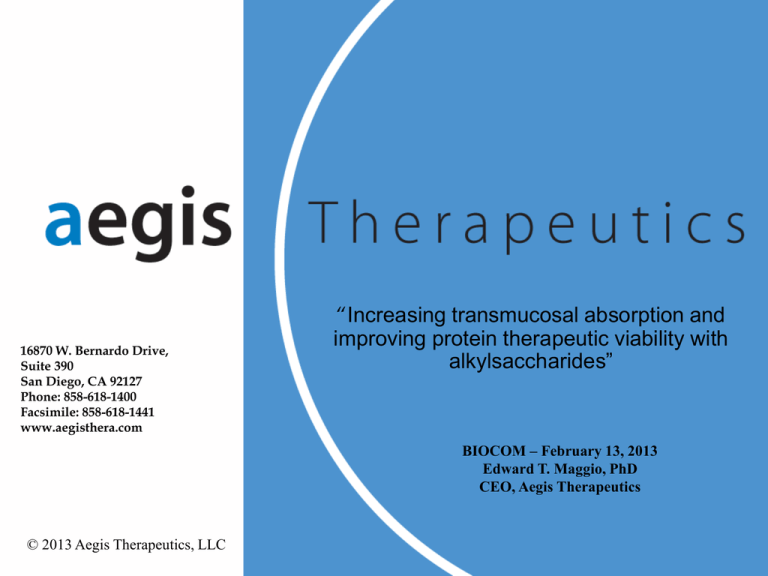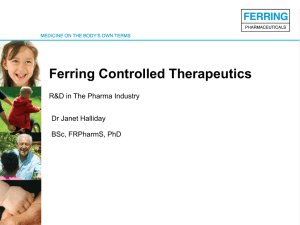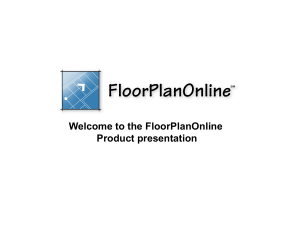
16870 W. Bernardo Drive,
Suite 390
San Diego, CA 92127
Phone: 858-618-1400
Facsimile: 858-618-1441
www.aegisthera.com
“Increasing transmucosal absorption and
improving protein therapeutic viability with
alkylsaccharides”
BIOCOM – February 13, 2013
Edward T. Maggio, PhD
CEO, Aegis Therapeutics
© 2013
Aegis
© 2013
Aegis Therapeutics,
Therapeutics LLCLLC
Aegis’ Company Background
Located in San Diego
We out-license advanced intranasal & transmucosal
delivery and stabilization technologies for therapeutic
proteins, peptides, and small molecule drugs (Aegis’
Intravail® & ProTek® technologies)
Patented technology from the UAB medical school exclusive license; additional patents recently issued and
pending worldwide
Multiple product-specific licenses issued to date: ~30
research licenses for ~34 API’s; 8 full commercialization
licenses with more conversions in negotiations
© 2013 Aegis Therapeutics LLC
2
Intravail®/ProTek® Technologies - Based on
Alkylsaccharides (sugar + alkyl chain - various linkages)
Typical oligosaccharides:
maltose
maltotriose
maltotetraose
sucrose
trehalose
O
sucrose
trehalulose
COCH2
H3C
turanose
(CH2)
nn O
maltulose
leucrose
OH
palatinose
isomaltose
OH
maltitol
OH
CH2OH
CH2OH
O
O
OH
OH
OH
HOCH2 O
OH
CH2OH
OH
Typical alkyl chain lengths:
10-18 carbons
© 2013 Aegis Therapeutics LLC
CH3
(CH2)
nn
O
OH
O
O
OH
Typical linkages:
glycosidic
thioglycosidic
amide linkage
ureide
ester
3
Multiple Modes of Transmucosal Delivery
for Macromolecular Drugs
Nasal
Metered spray pumps
Oral (gastrointestinal)
Gelcaps
Tablets
Oral cavity (buccal, sublingual)
Flash dissolve
Edible films
© 2013 Aegis Therapeutics LLC
4
5
Intravail® Opens Tight Junctions
Paracellular Absorption Demonstrated by Reduction in TEER*
(Normal Human Tracheal/Bronchial Epithelial Cell Derived Mucociliary Tissue)
Intravail® Excipients
% TEER Decrease
120
100
80
Non-Intravail®
Alkylsaccharides
60
40
20
0
PB
S
Ty
pe
A,
0.
Ty
1%
pe
A,
0.
Ty
2%
pe
B,
0.
Ty
1%
pe
B,
0.
2%
Ty
pe
C,
0.
Ty
1%
pe
C,
No
0.
n2%
In
tr.
X
,0
No
.1
n%
In
tr.
X,
No
0.
n2%
In
tr.
Y,
No
0.
n1%
In
tr.
Y,
0.
2%
0.1% 0.2% 0.1% 0.2% 0.1% 0.2% 0.1% 0.2% 0.1% 0.2% PBS
C14M
C12M
C12S
C8G
C7G
*Adapted from: Chen,S.-C., Eiting,K.T.,Li, A.A.W., Lamharzi, N. and Quay, S.C. (2005), 45th American
Society for Cell Biology Meeting, December 10-14, 2005, San Francisco (late abstract) Peptide Drug
Permeation Enhancement By Select Classes of Lipids
Key: M≡Maltoside, S ≡ Sucrose ester, G ≡ Glucoside
© 2013 Aegis Therapeutics LLC
*1h. exposure
6
Intravail® Induces Transcytosis in Nasal Epithelium
(Transmission Electron Microscopy)
Without Intravail® Enhancer
With Intravail®-TDM Enhancer
v
cc
gc
n
n
(cc) ciliated cell
(n) Nucleus
(gc) goblet cell
(v) vesicle
© 2013 Aegis Therapeutics LLC
gc
cc
Rat Nasal Epithelium
Magnification 3500X
Intravail® Enhances Nasal Epithelium Absorption
of FITC-Insulin
(Fluorescence Light Microscopy)
Without Intravail® Enhancer
With Intravail®-TDM Enhancer
Rat Nasal Epithelium
Magnification 40X
© 2013 Aegis Therapeutics LLC
7
Reversible Effect of Intravail®-TDM
Enhancer on Nasal Mucosa
Rat Model Data
Somatropin
350
300
0 minutes
60 minutes
120 minutes
250
200
150
100
50
0
0
40
80
Time (minutes)
© 2013 Aegis Therapeutics LLC
120
Serum Somatropin (ng/mL)
Plasma Calcitonin (pg/mL)
Calcitonin
50
40
30
20
10
0
0 20 40 60 80 100120
Time (minutes)
8
Intravail® Provides Intranasal
Bioavailability Comparable to Injection
OB-3 ~1kDa B/A=363%
Diazepam 0.28kDa B/A=96%
© 2013 Aegis Therapeutics LLC
9
Relatively Tight CV’s Upon Nasal Administration
Insulin
Courtesy of Drs. E. Meezan and D. Pillion, Univ. Alabama, School of Medicine, Birmingham
© 2013 Aegis Therapeutics LLC
10
Intravail® Speeds Onset of Action
11
Cuts Tmax in half vs. s.c. injection
Tmax (Average Minutes)
70
60
50
40
30
20
10
0.060%
0.125%
0.250%
0.500%
Intravail™ DoseConcentration
Intravail®-TDM
Calcitonin Insulin
© 2013 Aegis Therapeutics LLC
Leptin
SubQ
Somatropin (HGH)
3-Way Human Crossover Study —
Increases Calcitonin Bioavailability >5-fold
Intravail®
Mean Plasma Drug Concentration vs. S.C. Injection in 10 Healthy Females
60
Average Intravail® bioavailability ~37%
50
Concentration
Plasma
Calcitonin
ng/mL
No Intravail® control ~ 6.6%
40
30
20
10
Time (hrs)
Injection
© 2013 Aegis Therapeutics LLC
Nasal-No Intravail
Nasal + Intravail
4
3.75
3.5
3.25
3
2.75
2.5
2.25
2
1.75
1.5
1.25
1
0.75
0.5
0.25
0
0
12
2-Way Human Crossover - Intravail® Speeds
Sumatriptan Bioavailability by ~20X
Meanblood
± S.D.levels
Plasma
Profilesat
for2Intravail®
Nasal
Spray
Equivalent
achieved
to 3 min. Sumatriptan
vs. 60 min. for
current
spray
(Tmax reduced from 60 min. down to 8 min.)
70
60
Concentration (ng/ml)
50
40
Control
Reference
Test Article A
Formulation
Drug, No
Intravail®
30
Drug +
Intravail®
20
10
0
0
1
2
3
4
5
6
7
8
9
10 11 12 13 14 15 16 17 18 19 20 21 22 23 24
Time (hr) post-dose
US Pat. 8,268,791
© 2013 Aegis Therapeutics LLC
13
Intravail® Nasal Diazepam Provides Superior PK
Compared to Diastat® Rectal Gel
Intravail® Nasal Diazepam
(Licensed by Neurelis Therapeutics, San Diego, CA)
Bioavailability 96% vs. i.v. injection (vs. Diastat ~90%)
Tmax 1.5 hr (same as Diastat rectal gel)
Cmax 272 ng/mL (Diastat rectal gel ~262ng/mL)
Greater convenience/patient acceptance
Source: Neurelis Therapeutics, Phase I Study
© 2013 Aegis Therapeutics LLC
14
Multiple Modes of Transmucosal Delivery
for Macromolecular Drugs
Nasal
Metered spray pumps
Oral (gastrointestinal)
Gelcaps
Tablets
Oral cavity (buccal, sublingual)
Flash dissolve
Edible films
© 2013 Aegis Therapeutics LLC
15
Oral Octreotide with Intravail® Provides
4-fold higher Bioavailability vs. S.C. Injection
Uptake of 30ug Octreotide
in PBS s.c.
16
Oral Uptake of 30ug Octreotide
in Intravail®
7
60
A
B
6
311.63
50
5
Octreotide acetate (ng/ml)
Octreotide acetate (ng/ml)
AUC (ng/ml/min)
4
3
AUC (ng/ml/min)
1254.08
AUC1
AUC2
353.03
901.04
40
30
20
2
1
2
10
1
1
0
0
0
10
20
30
40
50
60
70
80
90
100
110
120
Ti m e ( m i nut e s)
Regulatory Peptides 167 (2011) 233–238
© 2013 Aegis Therapeutics LLC
130 140
150
160 170
180 190
0
10
20
30
40
50
60
70
80
90
100 110 120 130 140 150 160 170 180 190
Time (minutes)
Oral Delivery of [D-leu-4]OB3 Anti-Obesity Peptide
in Rodents (~1kDa MW)
Serum Peptide Conc. (ng/mL)
10000
With Intravail®
8000
552,710 ng*min/mL
~56% oral
bioavailability
6000
4000
2000
No Intravail®
137,585 ng*min/mL
0
0
20
40
60
Time (min.)
Lee et al. Regulatory Peptides 160 (2010) 129–132
© 2013 Aegis Therapeutics LLC
80
100
120
17
Oral Delivery of Exenatide & [D-leu-4]OB3 –
Synergy in Weight Loss & Glucose Control
Leinung MC & Grasso P (2012) Regulatory Peptides 179(1-3):33-8.
© 2013 Aegis Therapeutics LLC
18
19
AFPep Stops Growth of Human Tumor Xenografts
Oral AFPep cyclic 9-mer – Blocks Hsp-70 anti-apoptotic protein – Projected oral
human dose ~200 - 500μg/day; Non-toxic at 200X-1,000X effective dose
Tamoxifen Sensitive
Breast Cancer
Tamoxifen Resistant
Breast Cancer
Control
Control
AFPep
Tamox
AFPep
© 2013 Aegis Therapeutics LLC
Intravail®
Potentiates Oral Anti-estrogenic
Activity of AFPep by ~ 5X
Uterine Hyperplasia Pharmacodynamics Assay
AFPep
AFPep in Saline
μg p.o.
Inhibition of E-2 Stimulated Growth of Immature Mouse Uterus, %
100
10
1
0.1
41 + 4
41 + 6
33 + 4
6+4
AFPep in 0.3 % Intravail
47 + 3
40 + 5
43 + 4
28 + 8 *
* Significantly different from AFPep in Saline p < 0.01 Wilcoxon analysis
Data courtesy Dr. Jim Bennett et al, Albany Medical College
© 2013 Aegis Therapeutics LLC
20
21
Intravail® Oral Antisense
Drug Absorption in Primates
Conducted by Aegis-licensee
Six canulated monkeys for IJ administration
Antisense oligonucleotide - MW ~ 7KDa
Absorption without Intravail® - not detectable
Absorption with Intravail® - up to 18%
Eight-fold reduction in required excipient volume
No decapitation of intestinal pili
Presently optimizing the formulation
© 2013 Aegis Therapeutics LLC
Multiple Modes of Transmucosal Delivery
for Macromolecular Drugs
22
Nasal
Metered spray pumps
Oral (gastrointestinal)
Gelcaps
Tablets
Oral cavity (buccal, sublingual)
Flash dissolve
Edible films
© 2013 Aegis Therapeutics LLC
23
Intravail® Enhancement of Buccal Absorption
Ex Vivo
Flux of Lidocaine Across Porcine Buccal and Palatal Mucosa
Enhancement Ratio
Vehicle
Water (No Excipient Control)
Buccal
Tissue
Palatal Tissue
(keratinized)
1
1
Intravail® B3 Alkyl Saccharide
22.2
14.5
Non-Intravail® Alkyl Saccharide I
1.2
1
Non-Intravail® Alkyl Saccharide II
0.8
1.1
Non-Intravail® Alkyl Saccharide III
1.2
1.1
Transcutol®:Water (50:50)
2.3
10.9
Ethanol:Water (50:50)
1.3
3.5
© 2013 Aegis Therapeutics LLC
Intravail® Enhancement of Desmopressin
Absorption in Flash-dissolve (Buccal) Format
Desmopressin (pg/mL)
Desmopressin PK Following Buccal Administration in Monkeys
60
50
Monkey #1
Monkey #2
Monkey
50μg
dose,#3
mean 50µg
n=3Buccal
animals,
40
30
20
dissol. time 3 sec.
10
73
3
64
1
54
9
45
8
36
8
27
6
18
4
93
2
0
Time (minutes)
Therapeutic threshold (10 pg/mL) surpassed at 15 min.
© 2013 Aegis Therapeutics LLC
24
Intravail® Flash-Dissolve Desmopressin vs.
Oral Comparisons
Comparable PK Parameters for Intravail®-Flash Dissolve vs.
Currently Available Oral Dosage Forms
12-Fold Relative AUC
Increase vs. Sublingual
Liquid
23-Fold Relative AUC
Increase vs. Chewable
Tablets
© 2013 Aegis Therapeutics LLC
25
26
Protein Aggregation and Immunogenicity
Defining the Problem
Current Formulation Practice
Need for Alternatives
Regulatory Impact
Fibrils of a linear octapeptide CD4 blocker
form within 10 min. of aqueous dissolution
(electron micrograph).
© 2013 Aegis Therapeutics LLC
27
Problems Caused by Protein Aggregation
Loss of efficacy
Altered PK
Increased immunogenicity
Anaphylaxis or skin sensitization
Reduced shelf-life
Manufacturing yield losses due to membrane or
column fouling or precipitation
mAb’s particularly prone to aggregation
© 2013 Aegis Therapeutics LLC
28
Surfactants Counteract Protein Aggregation
Surfactants prevent or reduce aggregation
This results in stabilized bioactivity and reduced
immunogenicity
Polysorbates (i.e. PS-20 and PS-80) are the most commonly
used anti-aggregation surfactants
Highly effective at preventing aggregation
Well-accepted excipients - long track record of use
© 2013 Aegis Therapeutics LLC
Composition of polysorbate 20 and polysorbate 80
(Tween 20 and Tween 80
•Mixtures of structurally-related fatty acid esters of polyoxyethylene sorbitan.
•Polyoxyethylene chains vary in length with the average number of monomer moieties
totaling (W+X+Y+X) approximately 20 for Tween 80.
•Principal fatty acids - lauric acid and oleic acid comprising up to 60% of the total fatty
acid composition with esters of fatty acids of different chain length making up the
remainder of the molecules
•Common impurities: polyoxyethylene, sorbitan polyoxyethylene, and isosorbide
•Plus spontaneously formed oxidation products whenever O2 is present
© 2013 Aegis Therapeutics LLC
29
Spontaneously Formed Oxidation products
Polysorbate 20 and Polysorbate 80
Reactive
Contaminant Species
Site of Damage
Alkyl Peroxides
methionine, histidine, and
tryptophan moieties
Aldehydes
Primary amines
Epoxy Acids
Accessible nucleophiles such as
those found in lysine, histidine,
cysteine, and tyrosine
© 2013 Aegis Therapeutics LLC
30
Examples of Peroxide Assay of Random
Polysorbate Samples
Following re-purification
peroxides are detectable
within a few weeks upon
air exposure
Alkyl
saccharide
© 2013 Aegis Therapeutics LLC
Ray W.J. Jr. et al. Anal. Biochem., 146(2):
307-12, 1985.
31
Problems with Polysorbates
32
Underlying chemical structures spontaneously oxidize to
peroxides, epoxy-acids and aldehydes
These reactive elements increase immunogenicity
Non-immunologic hypersensitivity and anaphylactoid
reactions have also been attributed to poylsorbates in
biotherapeutics
Growing immunogenicity concerns by regulatory
authorities, physicians, and patients creates a need to find
non-reactive alternative surfactants
© 2013 Aegis Therapeutics LLC
ProTek® Alkyl Saccharide Excipients Possible Alternatives to Polysorbates
Prevent aggregation
Reduce immunogenicity
Increase shelf-life
Reduce denaturation due to elevated temperatures
and shear force
Increase reproducibility of lyophilizates upon
reconstitution
Extend patent franchise of existing biotherapeutics
through formulation “Compositions of Matter”
© 2013 Aegis Therapeutics LLC
Provided Courtesy of Aegis Therapeutics, LLC
33
ProTek®
Stabilization of Insulin–pH 6.5 & pH 7.5
37°C, 150 RPM Continuous Agitation – 90 days
Stabilization of Humulin-R, pH 6.5
ProTek® Type vs. Concentration
© 2013 Aegis Therapeutics LLC
Stabilization of Humulin-R, pH 7.5
ProTek® vs. Non-ProTek® Isomer
34
Stabilization of β-Interferons
37°C, 150 RPM Continuous Agitation
ProTek®
Stabiliz ation of be ta-I nte r fe r ons
100
No ProTek®
Excipient
R e l. Light Scatte r, 500nm
80
Betaseron
60
No ProTek®
Excipient
40
Rebif
With ProTek®
Excipient
20
0
0 .0
With ProTek®
Excipient
5 .0
1 0 .0
1 5 .0
2 0 .0
Da y
Patent Pending
© 2013 Aegis Therapeutics LLC
Provided Courtesy of Aegis Therapeutics, LLC
2 5 .0
3 0 .0
3 5 .0
4 0 .0
US Pat. No. 8,084,022
35
36
Some Other Examples of ProTek®
Stabilization (150 RPM, 37o - 40oC)
Human Growth Hormone
37 Deg. C. , Continuous Agitation @ 150 RPM
PTH Type I 40 Deg. C @ 150 RPM
Os tabolin C, pH 5.0, 40 deg. C
1000
No ProTek® Excipient
Rel. Light Scat ter, 500 nm
100
No ProTek® Excipient
80
60
40
US Pat. No. 7,425,542
800
600
400
200
US Pat. No. 8,076,290
With ProTek® Excipient
0
20
With ProTek® Excipient
-2 0 0
0
0 .0
5 .0
1 0 .0
1 5 .0
0
2 0 .0
1
2
4
5
Stabilization of Pramlintide and Calcitonin
800
No ProTek®
Excipient
1 0 .0
8 .0
6 .0
Pramlintide
4 .0
2 .0
With ProTek®
Excipient
0 .0
-2 .0
Calcitonin
5 .0
1 0 .0
1 5 .0
No ProTek®
Excipient
With ProTek®
Excipient
2 0 .0
Day
© 2013 Aegis Therapeutics LLC
2 5 .0
3 0 .0
3 5 .0
4 0 .0
Relat ive Light Scatt er, 500 nm
1 2 .0
-4 .0
0 .0
3
Day
Day
Relat ive Ligh t S cat t er ( 500n m)
R e l. Light Sc atte r , 500nm
120
Monoclonal Antibody
(IgG-3) 40 Deg. C @ 150 RPM
I gG-3 (QE D Sample 1) pH 5.0
700
No ProTek® Excipient
600
500
400
300
US Pat. No. 8,226,949
With ProTek® Excipient
200
100
0 .0 0
0 .5 0
1 .0 0
1 .5 0
2 .0 0
Day
2 .5 0
3 .0 0
3 .5 0
4 .0 0
Intravail®/ProTek® Safety Profile
Safe, odorless, tasteless, non-toxic, non-mutagenic, and nonirritating
Chemically synthesized molecules - metabolize to CO2 & H2O
Nonionic, non-denaturing, and pharmaceutically compatible
with virtually any protein, peptide or drug
Non-sensitizing and non-irritating to the rabbit eye @ 25%
concentration
Mild surfactants used in personal care and food products
(NOEL ~ 20g/kg bw); designated as “GRAS” by FDA
W.H.O. ADI ~ 15,000X the daily intake (~41 yrs of daily use)
© 2013 Aegis Therapeutics LLC
37
Intravail®
Summary
38
Allows non-invasive delivery of large and small molecule
drugs (enhanced mucosal absorption)
Unmatched intranasal bioavailability (up to ~30kD)
Rapid onset of action
Avoidance of gastric hydrolysis & “first pass effect”
Elimination of needle stick injuries/infections
Compatible with “off-the-shelf” metered nasal spray
devices and oral dosage forms
High oral bioavailability for certain peptides/non-peptides
Greater patient convenience and compliance
Low cost of GMP Intravail® excipients
© 2013 Aegis Therapeutics LLC
39
ProTek® Summary
Increased stability
Aggregation reduction
Reduced intrinsic immunogenicity
No peroxide damage or peroxide induced
immunogenicity
Higher manufacturing yields
Less stringent “cold-chain” requirements
Extended patent franchise for existing
biotherapeutics through formulation
“Compositions of Matter”
© 2013 Aegis Therapeutics LLC
Provided Courtesy of Aegis Therapeutics, LLC
16870 West Bernardo Drive, Suite 390
San Diego, CA 92127
Phone: 858-618-1400
Facsimile: 858-618-1441
www.aegisthera.com
Contact Information:
Edward T. Maggio, Ph.D., Chief Executive Officer
emaggio@aegisthera.com
Ralph R. Barry, Chief Business Officer & CFO
rbarry@aegisthera.com
© 2013 Aegis Therapeutics LLC

![Your_Solutions_LLC_-_New_Business3[1]](http://s2.studylib.net/store/data/005544494_1-444a738d95c4d66d28ef7ef4e25c86f0-300x300.png)




